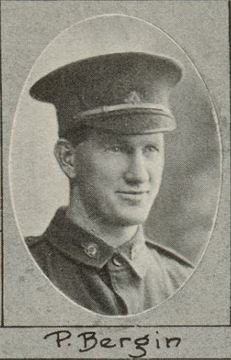
BERGIN, Philip
| Service Number: | 3687 |
|---|---|
| Enlisted: | 20 September 1915, Place of Enlistment Townsville, Queensland. |
| Last Rank: | Private |
| Last Unit: | 15th Infantry Battalion |
| Born: | Bundaberg, Queensland, Australia, 18 July 1888 |
| Home Town: | Townsville, Townsville, Queensland |
| Schooling: | Not yet discovered |
| Occupation: | Labourer. |
| Died: | Killed in Action, France, 8 August 1916, aged 28 years |
| Cemetery: |
No known grave - "Known Unto God" Villers-Bretonneux Memorial, Villers-Bretonneux, Picardie, France |
| Memorials: | Australian War Memorial Roll of Honour, Townsville Cenotaph, Villers-Bretonneux Memorial |
World War 1 Service
| 20 Sep 1915: | Enlisted AIF WW1, Private, 3687, 15th Infantry Battalion, Place of Enlistment Townsville, Queensland. | |
|---|---|---|
| 30 Nov 1915: | Involvement Private, 3687, 15th Infantry Battalion, Battle for Pozières , --- :embarkation_roll: roll_number: '11' embarkation_place: Sydney embarkation_ship: HMAT Suffolk embarkation_ship_number: A23 public_note: '' | |
| 30 Nov 1915: | Embarked Private, 3687, 15th Infantry Battalion, HMAT Suffolk, Sydney |
Private Philip Bergin
SERVICE PERSON’S STORY/EULOGY: Prepared by Glenn EdwardsPhilip Bergin was born in Bundaberg, Queensland,in 1889 before moving to Townsville. He was a labourer before making the decision to enliston 20 September1915at the age of 27.Philip Berginwas a typical young Australian-freckles, fair complexion, grey eyes and auburn hair. Private Berginjoined the 15th Battalion, which was raised six weeks after the startof the First World War. The 15thBattalion consisted mainly of volunteers from Queensland, with few from Tasmania. The 15thBattalionwas part of the 4th Brigade commanded by Colonel John Monash.Berginembarked on30 November1915for Gallipoli and departed from Sydney on board the transport ship HMAT A23 Suffolk. Bergin and his battalion arrived in Egypt on6 March 1916 but by this time the campaign in Gallipoli had ended. In Egypt,the Australian Imperial Forcewasexpanded and Bergin’s15th Battalion gained the experienced soldiersfrom Gallipoli. Bergin was now part of the 4th Australian Division which sailed for France and the Western Front in June 1916.On arrival in Francein July, Berginfound himself in trouble when he was charged for being AWOL –absent without leave -on 31 July 1916. Bergin was ‘missing’ from 2.00 pm to 5.30 pm –no doubt taking the opportunity to enjoy life before heading to the front lines. In August 1916,Bergin and his battalion took part in their first action –the Battle of Pozières. The villageof Poziereswas first captured by the Australian 1st Division on 23 July 1916. The division clung to its gains despite almost continuous artillery fire and repeated German counter-attacks but suffered heavily.In August Bergin’s battalion was sent in at Mouquet Farmto seize the area around Pozieres.The Battle of Mouquet Farm was thelast of the battles in Pozieres involving Australian troops. Theirpurpose was to clear the Germans from the heights around Thiepvalbut Mouquet Farmlay directly in the line of advanceand was heavily fortified by the Germans. Starting on8 August, Bergin and the 4th Australian Division was to seize the approaches to Mouquet Farm and thencapture the farm by 14 August. As the battle started, the artillery of both sides was so heavy that all landmarks were obliterated and the attackers became disoriented and lost. By 14 August the Australians were still fighting to capture the trench systemaround the farm. The 4th Division had taken 4649 casualties and on 15August was replaced by the 1st Division. At some point on the first day of the Battle of Mouquet Farm,Private Philip Bergin disappeared during the heavy fighting and bombardment. He was 26 years old.A month after his disappearance, Bergin’s mother was notified that he was missing in action. She was then informed that he was a prisoner of war in Germany. An official inquiry on 1 May 1917 declared that Bergin had been killed in action. His mother was notified officially of the death of her son and all hope of his return was lost.Today, Philip Bergin is commemorated in Townsville with a road named in his honour and his name on the World War 1memorial in Anzac Park. Philip Bergin’s courage and sacrifice is best expressed in the words on the memorial:“The Names of those who paid the priceFor us and the land we love,Be beacon fires to all who move On lowlier ways of sacrifice”
Submitted 1 June 2021 by Lynette Turner











